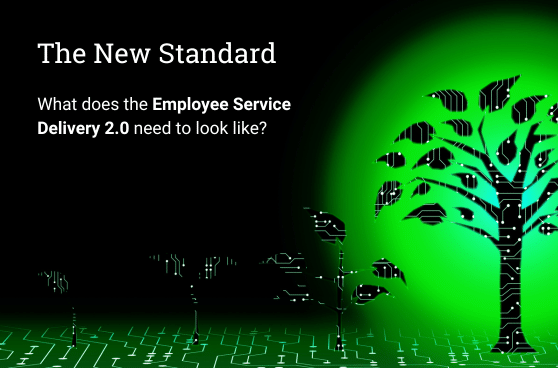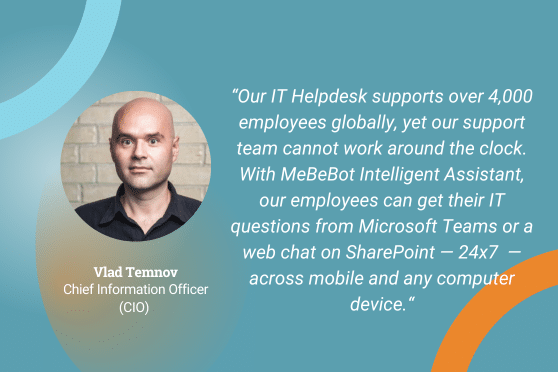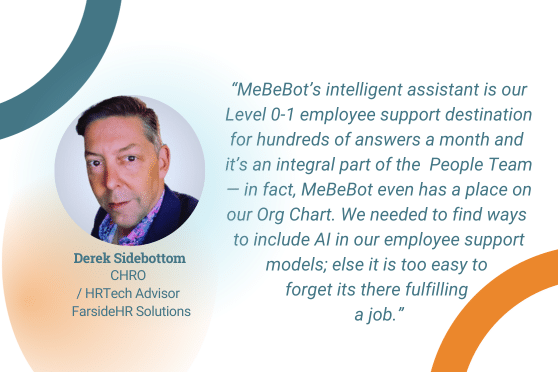Employee Support Experience 2.0 (ESX 2.0) is not just an option—it’s a necessity. As organizations strive to harness the power of AI for employee support, internal communications and employee engagement, the quest for an optimal ESX 2.0 experience becomes paramount. This article embarks on a comprehensive journey through the multifaceted realms of ESX 2.0 — exploring topics that define and redefine the paradigm. We delve into the core of ESX 2.0, what it must look like, and the key transformations required to make it a reality. From defining employee support delivery levels to operationalizing a framework for success, this exploration promises to be an insightful guide for organizations looking to enhance their employee service experience. Let’s navigate through ESX 2.0 and uncover what the future holds for the modern workforce.
Defining Employee Support Delivery Levels.
Workplaces’ employee support experience needs to be more cohesive and clearer. Levels 0-1 support often provides employees with a more robust automated solution than the other support functions. Employees often can go to a portal to review easily accessible information to troubleshoot their concerns. If they need additional help, an escalation path is available. While employees can obtain information in this method, they may not be able to provide feedback on the quality of experience.
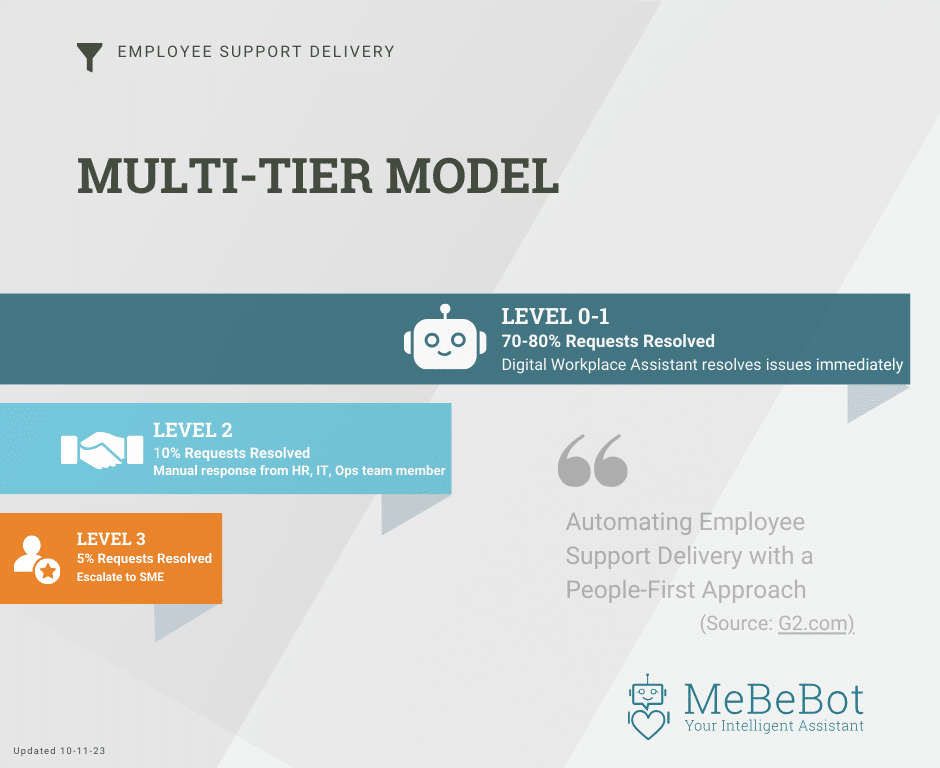
Level 0-1 – Employee Support Self-Service – Self-service technology allows employees to search for their information to troubleshoot and find solutions without contacting support functions directly. In addition , if employee queries are not abled to be answered, escalation automation will be triggered.
Level 2 – Subject Matter Expert – Assigned to the appropriate subject expert for review and resolution. If the request is more complex, it is routed to the next level.
Level 3 – Intervention Specialist – Direct interaction or intervention from a strategic professional to take multiple steps to resolve.
Create Employee Support Heat Map.
Before jumping into the world of AI, carefully examine current workplace processes and procedures for your employees. Check how things work and find out where problems might be. This step is like generating a “heat map” that shows problem areas (time consuming, outdated, inefficient, etc.). As well as where AI and/or automation can step in and make things even better for employees. Gather data through focus groups or role shadowing, to surface these areas for improvement. Through a one-team mindset, people managers find ways to track workplace activity data. For example, a company reviews its digital employee life-cycle processes. Opportunities for improvement generate actionable ways these processes can benefit from AI / automation.
Five Employee Support Delivery Transformations Needed for a New Era.
The role of employee support delivery is undergoing a significant transformation. To adapt to the changing needs and expectations of the modern workforce, organizations must embrace five essential changes.
- The centralization of support functions across all departments is paramount. This shift streamlines the employee experience, making it a shared responsibility across the entire organization, creating a unified, one-team approach.
- Meaningful connections with employees have moved beyond mere rhetoric. Automated, personalized, real-time support and employee engagement are now at the forefront. This not only fosters continuous improvement but also ensures that employees are heard, making them an integral part of the process.
- A seamless user experience is no longer a luxury but a necessity. This transformation involves creating an employee-centered user experience with compatibility and integration across systems. In this new era, information flows effortlessly, simplifying work for employees.
- The utmost attention must be given to data security and privacy concerns. Protecting sensitive company information and, more importantly, earning and maintaining employee trust is non-negotiable.
- Investing in change management is critical to navigating these transformations. It not only strengthens user adoption but also facilitates a smooth transition, ensuring that employees and the organization as a whole are well-prepared for the changes ahead.
These five transformations represent the vanguard of the employee support delivery evolution. By embracing them, organizations position themselves to thrive in a workplace that’s constantly evolving, offering employees a more streamlined, personalized, and secure experience.
The Evolution From Employee Support Delivery To Employee Service Experience.
Integrating processes and people into a unified employee experience is now a necessity. This shift goes beyond creating a seamless workplace; it’s about fostering deeper connections among employees, uncovering valuable insights, and utilizing actionable data to enhance operational efficiency and productivity. Simultaneously, it nurtures a company culture where employees are not just heard but genuinely seen.
Transitioning from traditional, often manual, multi-step support processes to a streamlined, interactive service delivery experience is the key to transforming from employee support delivery to employee service experience. Here, employees can access personalized services with just a few clicks, guided through scenarios based on their input, all without human intervention.
This fresh approach empowers companies to ensure employees have what they need, effectively manage benefits, track individual job performance, and provide opportunities for personal growth and development.
The true game-changer in this transformation is the integration of Artificial Intelligence (AI). AI takes on laborious manual tasks, streamlines onboarding, answers employee queries, and resolves common issues, saving time and reducing hassles.
AI’s real power extends to personalization, using data analysis to understand each employee’s needs and preferences. It facilitates internal communications and feedback collection from specific employee groups, serving as an ever-present, intelligent assistant for a wide range of workplace questions. This not only elevates employee satisfaction but also enhances productivity and efficiency.
Exploring Employee Support Experience 2.0.
Employee Support Experience 2.0 (ESX 2.0) is a revolutionary paradigm that redefines how organizations interact with their employees. It represents a dynamic shift towards a more consumer-like, globally accessible employee self-service experience, backed by expert-level 24/7 support for a wide array of workplace services, benefits, policies, procedures, processes, and programs. ESX 2.0 thrives on evolution and automation, particularly in providing Level 0-1 support, all the while forging close partnerships with operations / support team functions.
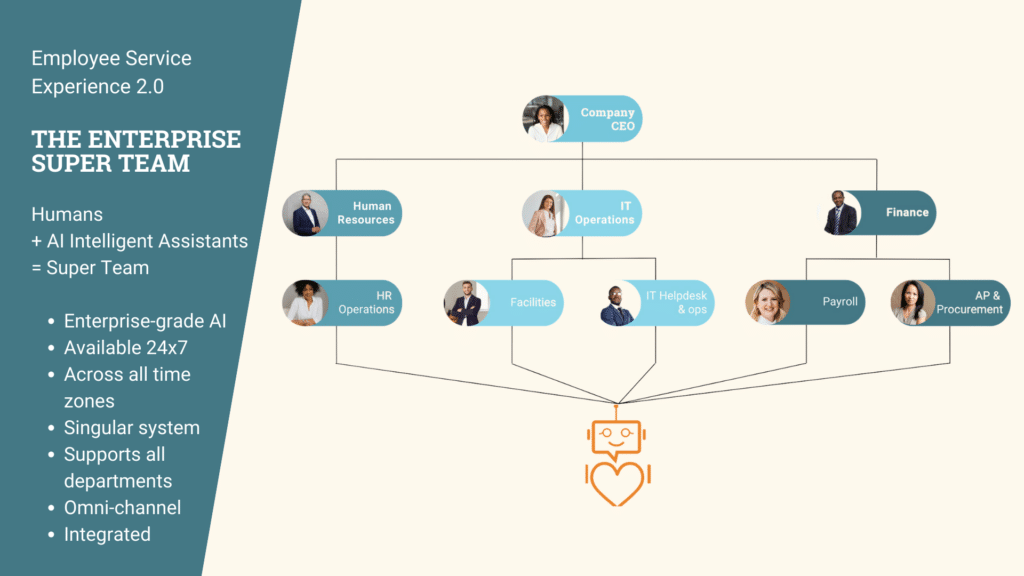
Characteristics of Employee Support Experience 2.0:
- Consumer-Centric Service: ESX 2.0 delivers a self-service experience reminiscent of consumer applications, ensuring employees have access to essential information around the clock.
- Collaborative Automation: It expertly automates Level 0-1 support while engaging in constant collaboration with operations / support team functions.
- Centralized Knowledge Base: ESX 2.0 boasts a centralized knowledge base that taps into the current employee context and everyday workplace questions, tailoring responses for a personalized experience.
- Data-Driven Enhancement: It collects and shares employee feedback and data to inform service delivery improvements and strategies, working closely with support team function leadership.
- Conversational Expertise: ESX 2.0 actively engages with employees to understand conversational workplace vernacular, continuously refining the quality of personalized answers.
- Onboarding Excellence: With the ability to provide personalized onboarding support, it significantly reduces employees’ ramp-up time and bolsters team business continuity.
- Targeted Engagement: ESX 2.0 collaborates with function experts to schedule and deliver meaningful push notifications to the appropriate audience.
- Pulse Surveys: It partners with function leaders to design, schedule, deliver, and collect data from tailored employee pulse surveys, ensuring real-time insights.
- Customization Assistance: ESX 2.0 provides pre-written Q&A templates for support function leaders, aiding in crafting custom questions and answers aligned with workplace processes.
Skills Required for ESX 2.0:
- Integration Expertise: Securely install in popular communication platforms such as Microsoft Teams, Slack, and Microsoft SharePoint, or function as a web chat.
- AI Mastery: Fluent in conversational, generative and authoritative AI, blending natural language processing with human-supervised machine learning, ensuring over 90% accuracy in delivered answers.
- Automation Proficiency: Extensive experience in automating Level 0 employee service delivery processes and procedures, employing crowdsourced techniques for training AI data language models.
- Global Availability: Capable of supporting employees with routine questions from anywhere in the world, providing 24/7 assistance.
- Communication Skills: Strong and active listening and communication skills are crucial.
- DEI Knowledge: Experience in Diversity, Equity, Inclusion, and Belonging efforts to promote adoption and usage of these programs.
- User-Centered Expertise: Ability to apply user experience, human-centered design, and user interface best practices.
- Data Analytics: Proficiency in data analytics and the art of data storytelling.
- People-First Focus: A people-first and results-driven orientation, ensuring accessibility and ease of use within the workflow.
- Workplace Knowledge: Comprehensive knowledge of employee workplace service and support Q&A, with mentoring and coaching by other leaders.
- Collaborative Mindset: A collaborative, growth-oriented mindset, open to feedback, and the ability to implement improvements swiftly.
ESX 2.0 represents a holistic approach to elevating the employee experience, resulting in more accessible, personalized, and data-driven, all while providing expert support around the clock. Those who embody these characteristics and skills will be at the forefront of this transformative paradigm.
Measuring the Impact of Employee Support Experience 2.0.
Employee Service Experience 2.0 (ESX 2.0) isn’t just a transformative system; it’s a catalyst for change and improvement. But how can we truly measure the success of this revolutionary approach to employee service delivery? Let’s delve into the key metrics and indicators that reveal the tangible impact of ESX 2.0 on your organization. Here are the benchmarks to consider when gauging the success of this paradigm shift:
7 Ways To Measure and View Success:
- Onboard and Launch Employee Service Delivery Level 0-1: The ability to efficiently onboard and launch your level 0-1 service delivery is a crucial step in the ESX 2.0 journey. A streamlined transition here indicates a successful start.
- Support and Answer 80% of Global Employees’ Routine Self-Service Questions: The ultimate measure of success is the extent to which ESX 2.0 supports and answers routine questions, reaching that 80% milestone indicates efficiency and effectiveness.
- Significantly Decrease External and Internal Employee Onboarding Ramp Time: Thus, a notable decrease in onboarding ramp time is a strong indicator that ESX 2.0 is contributing to improved team business continuity.
- Decrease Regrettable Attrition: The ability to reduce attrition rates by removing employee frustrations and delays in help desk responses is a critical metric that defines success.
- Improve Employee Engagement Scores: Successful implementation results in improved engagement scores, thanks to quick responses from pulse surveys that show the organization is actively listening and acting on feedback.
- Increase Time Spent on Strategic Work: As ESX 2.0 streamlines routine processes, it allows employees to devote more time to strategic work that fuels business growth, saving valuable hours for the organization.
- Significantly Increase Employee and Manager Capability and Productivity: A noticeable increase in the capabilities and productivity of both employees and managers is a testament to the system’s success in driving growth and efficiency.
These measurable outcomes reflect the transformation ESX 2.0 brings to your workplace. By assessing these key success indicators, you can gauge the real impact it has on your organization’s productivity, efficiency, and employee satisfaction.
Deeper Exploration Into Employee Support Experience 2.0.
Employee Service Experience 2.0 (ESX 2.0) stands as a beacon of transformation. ESX 2.0 redefines the way organizations connect with their employees, offering a comprehensive suite of functionalities that revolutionize the employee experience. Below is a checklist of ESX 2.0’s functionality, each designed to enhance communication, engagement, support, and efficiency within the workplace:
| FUNCTIONALITY | DESCRIPTION |
| Generative AI-Powered Answers | Utilize AI-powered assistance to generate reliable answers from company documents with human oversight. |
| Curated Global Knowledge Base | Access a curated knowledge base covering a wide range of topics ensuring information accuracy and reliability. |
| Verify & Authorize Answers | Implement a mechanism for verifying and authorizing answers to maintain compliance, consisstency and precision. |
| AI Intelligent Assistant Interface | Enjoy an AI-powered intelligent assistant integrated with Slack and Microsoft Teams. |
| People Analytics Dashboard | Gain valuable insights into employee engagement, queries, and specific needs within the organization. |
| Integrated Push Messaging | Facilitate direct and targeted real-time communication with employees, delivering announcements and alerts. |
| Conversational Pulse Surveys | Collect quick feedback from employees to gauge engagement, sentiment, and their specific needs. |
| Manager Effectiveness Development | Empower managers with a pre-built knowledge base, coaching tips, and communication resources. |
| System Integration | Seamlessly integrate ESX 2.0 into various platforms for efficient communication and support. |
| Multi-lingual | Ensure effective communication with global employees by offering support for multiple languages. |
| Escalation Service | Streamline issue resolution and communication by facilitating the escalation of employee queries. |
| Security / SOC2 Type 2 | Ensure the highest levels of data security and compliance, building employee trust in the system. |
Operationalizing Employee Support Experience 2.0: A Framework for Success.
As organizations embrace Employee Service Experience 2.0 (ESX 2.0), the journey towards operationalizing this transformative approach to employee service delivery becomes paramount. To successfully transition, it’s essential to manage various endpoints in the digital workplace, establish a Co-Shared Digital Workplace Strategy Committee, and implement a co-shared change management strategy. These three fundamental recommendations form the backbone of a robust framework to operationalize ESX 2.0 (Source: Mindy Honcoop, People Leader).
Managing Endpoints in the Digital Workplace
In the contemporary digital workplace, the management of various endpoints takes center stage, particularly for facilitating secure AI integration. Endpoint management encompasses the oversight of all devices and systems linked to your corporate network, spanning computers, mobile devices, IoT devices, and cloud services. To orchestrate effective endpoint management in the digital realm, commence by crafting a comprehensive inventory encompassing all endpoints within your organization. It is imperative to evaluate their configuration, security status, and compatibility with AI integration. Robust endpoint security measures are paramount, including the deployment of firewalls, antivirus software, and encryption, which form a protective shield against cyber threats and potential data breaches. Establishing stringent policies governing endpoint usage, access, and data handling is crucial for alignment with AI integration prerequisites and compliance standards.
Forming a Co-Shared Digital Workplace Strategy Committee
Successful AI integration hinges on the creation of a Co-Shared Digital Workplace Strategy Committee. This assembly of key stakeholders from various departments acts as a central hub for communication and the driving force behind continuous improvement. The committee should consist of IT executives and senior managers, offering technical expertise to align digital solutions with IT infrastructure. HR professionals, well-versed in employee needs, should advocate for a user-centric approach. Leaders from different departments contribute by aligning initiatives with specific business objectives. The vital input from employees who interact directly with systems is invaluable, and data management and security experts should address data-related compliance concerns.
Co-Shared Change Management Strategy
The committee takes on the pivotal role of crafting a communication plan for digital change. They select the most suitable communication channels, ensuring all stakeholders are well-informed and engaged throughout the transition. Continuous improvement falls under the committee’s purview, involving feedback collection, data analysis, and iterative system enhancements. Challenges and concerns are tackled head-on through a structured problem-solving and escalation process. Monitoring progress, tracking key performance indicators, and reporting to executive leadership and stakeholders are essential components of their responsibility. Providing extensive training to employees is integral, arming them with the knowledge and skills to utilize digital tools effectively. Finally, creating an environment that fosters experimentation and the sharing of digital experiences completes the change management strategy.
In this complex and dynamic landscape, operationalizing Employee Service Experience 2.0 requires a structured approach that embraces endpoint management, a strategy committee, and a change management strategy. By adhering to these recommendations, organizations can navigate the transformative path of ESX 2.0 with clarity and confidence.
5 Employee Support & Service Take-A-Ways.
For Chief Information Officers (CIOs):
- Strategic AI Integration: CIOs should strategically integrate AI, combining generative with authoritative AI for robust and verified solutions. The focus should be on enterprise-wide, omni-channel, and quick implementation to drive efficiency and cost-effectiveness.
- Comprehensive Data Utilization: Leverage data analytics and a 360-degree view of employees to optimize decision-making. Harness data for personalized communications and strategies, enhancing employee service experiences.
- Transformation of Support Delivery: Embrace five key transformations in employee support delivery, streamlining the process to provide an interactive and adaptive service delivery experience. This entails simplifying and tailoring processes, and the utilization of AI for automation.
- Focus on Employee Engagement: Place a strong emphasis on measuring the impact of ESX 2.0, utilizing metrics related to onboarding, attrition, and engagement scores. This proactive approach ensures that the system genuinely enhances the workplace.
- Operational Excellence: Implement a framework for operationalizing ESX 2.0, creating a Co-Shared Digital Workplace Strategy Committee, and fostering a co-shared change management strategy. This ensures a seamless transition and maximizes the potential of the new system.
For Chief People Officers / Chief Human Resources Officers (CPOs / CHROs)
- AI Intelligent Assistant: AI intelligent assistants provide real-time support and can handle complex inquiries, making support services more efficient and accessible.
- Predictive Issue Resolution: Utilize people analytics to anticipate and resolve employee issues before they escalate. This proactive approach not only improves service delivery but also enhances employee satisfaction.
- Personalized Support Journeys: Develop AI-driven support journeys that are tailored to each employee’s role, needs, and preferences. Personalization ensures that employees receive the most relevant and helpful support resources.
- Advanced Feedback Mechanisms: Implement real-time feedback systems that collect and analyze employee sentiment. This data helps identify areas for improvement and fine-tunes support services continuously.
- Multi-Channel Support Integration: Create a seamless and integrated experience across multiple support & services channels, allowing employees to switch between chat, email, phone, and self-service portals without losing context. This strategy ensures that employees can choose their preferred communication channel while receiving consistent service.
In conclusion, the concept of Employee Service Experience 2.0 has emerged as a pivotal paradigm shift in the world of employee support, communication, and engagement. This innovative approach signifies a commitment to integrating advanced technology, personalization, and people analytics to meet the evolving needs of the workforce. From cognitive service chatbots and predictive issue resolution to seamless multi-channel support, it’s just the start of reimagining what is possible in enhancing employee experiences. As organizations continue to adapt and innovate in the digital age, Employee Service Experience 2.0 stands as the new standard, embodying the principles of efficiency, personalization, and data-driven decision-making.
